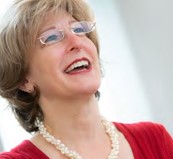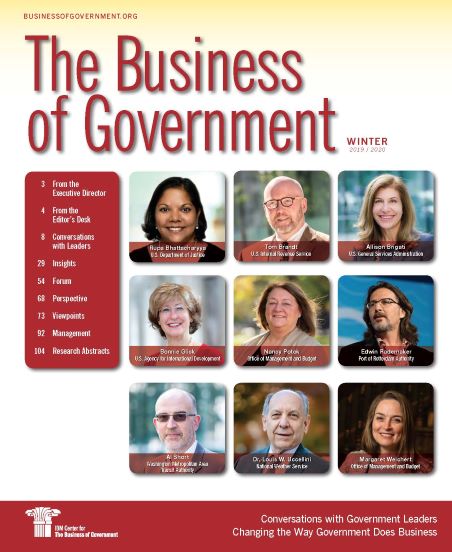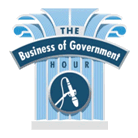
Providing Development and Humanitarian Assistance

USAID seeks to deliver sustainable development solutions. As part of its mission, USAID advances U.S. national and economic prosperity, demonstrates American cooperation, and promotes a path to self-reliance and resilience of aid recipients. The purpose of foreign aid should be ending the need for its existence, and USAID provides development assistance to help partner countries on their own development journey to self-reliance—looking at ways to help lift lives, build communities, and establish self-sufficiency.
Bonnie Glick, deputy administrator of USAID, joined me on The Business of Government Hour to discuss the agencies key priorities, its digital strategy, efforts to foster self-reliance, and how it engages the private sector to enhance development solutions. The following is an edited excerpt of our discussion.
What do we do at USAID? We reduce the reach of conflict around the world, so that conflicts that are breaking out, wherever those may be, impact the fewest number of people possible. We work hard to prevent the spread of pandemic diseases such as what is happening today with the Ebola outbreak in the Democratic Republic of the Congo. We work to counteract the drivers of violence around the world that can lead to instability and can lead to some terrible transnational crimes, things like human trafficking. We work to promote American prosperity through market expansions to enable the export of U.S. products. We create a level playing field for U.S. businesses around the world, particularly in emerging market countries. We support stable, resilient democratic societies. As the world’s preeminent humanitarian assistance provider, we support nations when disasters strike or when crises emerge.
USAID is an independent agency of the U.S. government. We are part of the president’s National Security Council. The U.S. foreign assistance budget is around $40 billion annually, of which USAID holds the largest portion. We are the largest development agency in the world.
I want to engage with the private sector, both international corporations and American-based international corporations, but also local private sectors because we want to make sure that programs that USAID funds and runs are sustainable. The best way for a program or a project to be sustainable is by having it run through a private sector lens where there are benefits that accrue both to the investors, businesses, donors, as well as to the beneficiary community.
Another big challenge we have centers around humanitarian assistance. The U.S. is the largest global bilateral donor of humanitarian assistance. A large component of what we do is working with other international donors to ensure that there is appropriate burden sharing in the costs associated with humanitarian responses, and that too is a way of ensuring that we’re good stewards of the taxpayer’s dollars.
We also face the challenge with the rise of alternative development models, which are in fact simply debt traps. These models are not about development. The Chinese model of development is about placing countries into debt traps that force them to give up national sovereignty. I would reference the recent experience of China’s financing and building of a port in Sri Lanka. Sri Lanka defaulted on the debt and lost control of this port. I talk to leaders of developing countries about the importance of considering all aspects of development projects as they are presented, particularly large-scale infrastructure projects.
On USAID’s Policy Framework. The USAID policy framework aims to bring the sort of ethereal, academic approach to development into the real-world operational space. In April 2019, we released the agency’s policy framework. It outlines USAID’s approach to its mission, vision, and strategic orientation around what we refer to as a journey to self-reliance. The policy framework allows us to be a better partner, strengthen our ability to accelerate development progress, while meeting urgent humanitarian needs. That framework makes USAID a more effective provider of foreign assistance on behalf of the American people.
To capitalize on development gains and to respond to complex challenges—the ones that present themselves in the new development landscape—we focus on what we are referring to as a journey to self-reliance. At the same time, we’re transforming our organization with a single goal in mind—working to end the need for foreign assistance. Our development model is rooted in building self-reliance in each of the countries in which we operate. For USAID, this is an explicit pivot toward a much more country-centric, locally led, and data driven approach to development assistance based on proven development best practices.
Our model of assistance promotes balanced trade, open market, democratic norms, and social inclusion. This means enabling locally led problem-solving for enterprise driven growth, inclusive societies, and transparent, accountable, citizen-responsive governance so that our partner countries have both the commitment and the capacity to solve their own development challenges real-world operational space. In April 2019, we released the agency’s policy framework. It outlines USAID’s approach to its mission, vision, and strategic orientation around what we refer to as a journey to self-reliance. The policy framework allows us to be a better partner, strengthen our ability to accelerate development progress, while meeting urgent humanitarian needs. That framework makes USAID a more effective provider of foreign assistance on behalf of the American people.
To capitalize on development gains and to respond to complex challenges—the ones that present themselves in the new development landscape—we focus on what we are referring to as a journey to self-reliance. At the same time, we’re transforming our organization with a single goal in mind—working to end the need for foreign assistance. Our development model is rooted in building self-reliance in each of the countries in which we operate. For USAID, this is an explicit pivot toward a much more country-centric, locally led, and data driven approach to development assistance based on proven development best practices.
Our model of assistance promotes balanced trade, open market, democratic norms, and social inclusion. This means enabling locally led problem-solving for enterprise driven growth, inclusive societies, and transparent, accountable, citizen-responsive governance so that our partner countries have both the commitment and the capacity to solve their own development challenges.
Our goal, ultimately, is to end the need around the world for foreign assistance. Different countries are in different places along that journey to self-reliance. There are countries that are at the beginning stages and countries that are closer to transitioning from an aid recipient country to a more partner- centered country—and even in many cases, to becoming a donor country itself.
The potential for digital technologies and services to drive widespread economic growth, to improve health outcomes, and to lift millions of people out of poverty is clear.Significant barriers still remain. The resulting gaps can slow global growth and can increase a country’s risk of instability. They can help keep countries dependent on foreign assistance. For example, four billion people in developing countries do not have access to the Internet and 1.7 billion women still lack access to a mobile phone.
On USAID’s Private Sector Engagement Policy. USAID is undertaking a major cultural and operational transformation to expand our engagement with the private sector. This will help us achieve outcomes of shared interest and shared value. One of the things that we focus on is open markets. Open markets send signals to investors, both in-country investors as well as foreign direct investment. We’re looking at ways to move countries from being foreign assistance recipient nations to foreign direct investment recipient nations. We think the private sector can help do just this.
One of the most exciting developments in the past year was the passage of the Build Act. The Build Act led to the creation of the new U.S. International Development Finance Corporation (DFC). It will combine all of the existing loan and loan portfolio guarantees that USAID has had historically through our development credit authority. Our development credit authority will be augmented with political risk insurance, loans, and loan guarantee products from the overseas private investment corporation, which was called OPIC. The new DFC is a blend of OPIC and some of USAID’s assets that will also have the authority to make direct equity investments in projects. We’re looking forward to working closely with the DFC to use its expanded set of potential tools so that we can directly support even more market driven private sector led solutions at a larger scale than ever before.








